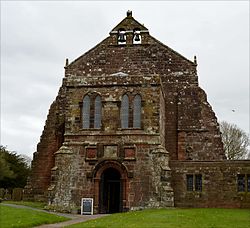Holmcultram Abbey

Holmcultram Abbey 2017
|
|
| Monastery information | |
|---|---|
| Full name | Holmcultram Abbey |
| Order | Cistercian |
| Established | 1150 |
| Disestablished | 1538 |
| Diocese | Carlisle |
| Site | |
| Location |
Abbeytown, Cumbria, England |
| Visible remains | Nave; still used as the parish church |
| Public access | Yes |
Holmcultram Abbey (alternatively Holm Cultram Abbey or Holme Cultram Abbey) was a Cistercian monastery in what is now the village of Abbeytown in Cumbria, United Kingdom. It was founded in 1150 and dissolved in 1538. After the dissolution the church continued to be used as the parish church.
The abbey was founded in 1150 by Cistercian monks from Melrose Abbey on land given by Allen of Allendale. The land was in territory held by Scotland at the time, and the grant of land was confirmed by Prince Henry. The abbey was built of stone from north of the Solway Firth The area was re-claimed by Henry II of England who confirmed the grant of land in 1157. The Abbey rented land in Galloway and held it for 200 years, disposing of it because, they said, it was no longer possible for Englishmen to hold land in Scotland.
The abbey steadily became prosperous, acquiring lands in north Cumberland and undertaking reclamation work along the Solway. In 1301 it was granted a market at Skinburness, together with permission to build a church. Following violent storms which devastated Skinburness, both permissions were transferred to Newton Arlosh, where the abbey built a heavily fortified church as a chapel of ease. Experience had shown that the abbey's Scots origins did not protect it from attacks by Scots raiders, from whom it suffered repeatedly from 1216 onwards, with a particularly severe attack in 1319, by Robert the Bruce, despite his father being buried there.
The community established a daughter house at Grey Abbey in Northern Ireland in 1193.
The monastic community was dissolved in 1538, when the parish petitioned for, and obtained, the use of the church, with the abbot becoming the first rector.
The buildings were of red sandstone from the other side of the Solway. Archaeological excavations from 2006 onwards have shown that the monastic buildings extended to the south of the church, and followed the usual Cistercian pattern. The church was along the north side of the cloister, with other buildings on the other three sides, the refectory being opposite the church and the chapter house to the west. The former abbey church underwent a series of structural accidents (such as the collapse of the tower in 1600) and alterations as a result of which it gradually shrank to comprise the first six bays of the nave, without aisles. In addition the roof was lowered to the height of a single storey and there were two energetic restorations in 1883 and 1913. This nevertheless left a large enough building to continue to serve to the present day as the parish church of Abbeytown.
...
Wikipedia
